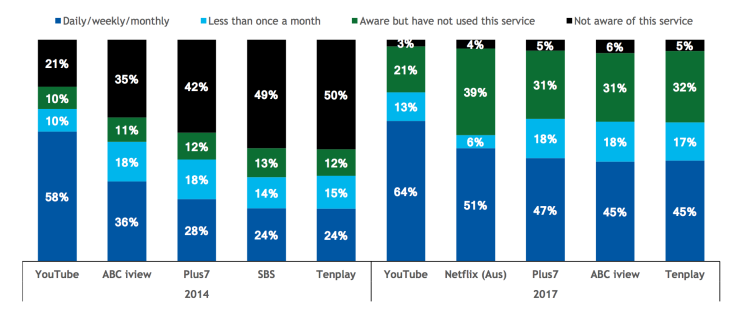In my previous blog post, I mentioned briefly how streaming sites are taking over broadcast television as the main way to watch television shows. The growth in popularity of sites like Netflix and Stan, is seemingly only impacting television. The film industry box office is not threatened by these sites, because home viewing cannot yet compete, and may never be able to compete with the movie theatre. Tim Richards, CEO of Vue Cinemas said in an interview with CNBC (2016), “Our competition is not Netflix. It’s not the internet. It is sporting events, it is bowling, it is nightclubs”. It is the TV industry which seems to be affected the most by streaming services. According to a report by Nielsen for Screen Australia (2017), in 2014 YouTube dominated the online viewing experience, TV on demand sites i.e websites owned by broadcast stations were not well know, and Netflix didn’t exist in Australia at the time (Netflix launched in Australia in 2015). Since then, YouTube remains the most popular online viewing platform, with Netflix coming in second, and the use and knowledge of TV on demand sites has increased: up from 50-75% of people knowing about them to 90-95%, from 24-36% of people using them to 45-51% across the various channels.

The big draw factor of streaming services is the ability to binge watch, rather than having to wait week by week. The platform is designed for the mass consumption of shows, with all episodes of a series available at once, and each one playing seconds after the previous one finishes. To maintain relevancy “networks are more often building programming and marketing around live viewing by promoting social media conversation” (Sharma, R 2016). The Netflix format can also influence a viewer’s perception of a show. As Romil Sharma (2016) puts it “If a show fails to woo us on episode one, the next episode is a mere 15 seconds away from starting. Why not give it the benefit of the doubt?”. It is much easier to get into a show if you can watch the first three episodes in a matter of hours, rather than having to commit to several days of waiting in between. Equally, the sheer size of the catalogue, allows disliked shows to be quickly dropped in favour of something different.
In a New York Times report in 2012, Nick Bolton, made the claim that Internet Pirates Will Always Win. By comparing torrent sites like Pirate Bay to a game of whack-a-mole, Bolton reasoned that even if you took down one site, another would be developed. Even Pirate Bay, seems to be particularly resilient, “having survived being forcibly taken down almost a dozen times” (Nevola, J 2017). The site does this by shifting its domain to various different countries
- In 2012 TPB switches from .ORG to .SE, fearing a domain seizure.
- In 2013 TPB trades .SE for .GLover a pending lawsuit.
- TPB is not welcomein Greenland, switches to .IS.
- Swedish authorities go after the .IS domain, TPB moves to .SX.
- Sint Maarten’s registry suspends .SX domain, TPB relocatesto .AC.
- AC isn’t safe, so TPB sails to Peru.
- PE domain is suspended, next stop Gyuana.
- GY domain lasts only a few days, so TPB decides to move backto the SE domain.
- From Torrentfreak.com by Ernesto, May 20, 2016
With the proliferation of torrent sites, it is no wonder “Entertainment and software companies began to prophesize the end of their industries due to lost profits from piracy” (Nevola, J 2017).
However, according to the Screen Australia report (2017), there has been “a significant decline in content piracy amongst [Video On Demand] viewers, with 17% of respondents suggesting they had used unofficial streams or downloads, compared to 43% in 2014” . It is theorised that this is because when “primary distributors make their copyrighted work as easily accessible as pirated material, people will switch back to acquiring the work through legal channels” (Nevola, J 2017) .Ease of access, as well as the cost efficiency of streaming sites means they are the perfect option for those who want to watch several different movies, without having to buy each one separately. For the average price of one new release Blu Ray (approx. $25-$30 at JB HI-FI), 2 viewers can have access to the full Netflix catalogue for 2 months. It’s no surprise then that streaming sites are preferred to buying discs, and it’s a good sign that this is also decreasing the frequency of pirating.
References
Bolton N 2012, Internet Pirates Will Always Win, The New York Times, viewed 25th March 2018 <https://www.nytimes.com/2012/08/05/sunday-review/internet-pirates-will-always-win.html>
Nevola, J 2017, Internet Piracy: The Effects of Streaming Services and the Digital Marketplace, The Columbia Science Technology and Law Review, viewed 25th March 2018 <http://stlr.org/2017/11/14/internet-piracy-the-effects-of-streaming-services-and-the-digital-marketplace/>
Nielsen, 2017, Online and On Demand 2017, Screen Australia, viewed 26th March 2018 <https://www.screenaustralia.gov.au/fact-finders/reports-and-key-issues/reports-and-discussion-papers/online-and-on-demand-2017>
Richards, T in Gibbs, A 2016, Netflix and kill: Is streaming hurting movie theaters?, CNBC, viewed 25th March 2018 <https://www.cnbc.com/2016/09/15/netflix-and-kill-is-streaming-hurting-movie-theaters.html>
Sharma R, 2016, The Netflix Effect: Impacts of the Streaming Model on Television Storytelling, Wesleyan University Honours Thesis, viewed 25th March 2018 <https://wesscholar.wesleyan.edu/cgi/viewcontent.cgi?article=2591&context=etd_hon_theses>

Reblogged this on Future Cultures.
LikeLike